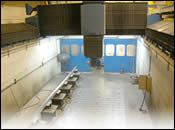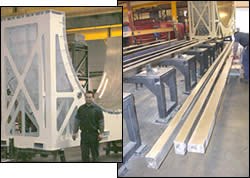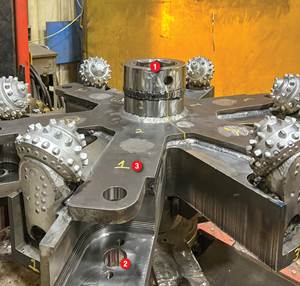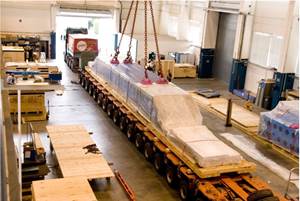Thinking Big
This shop specifies large machine tools for the machining possibilities of the future. To prepare for the feed rates the shop expects to use one day, the latest large gantry mills apply linear motors on all three linear axes.
Coast Composites doesn’t know of any cutting tools that can mill Invar faster than 1,200 ipm. This is the feed rate of the fastest passes the shop takes in Invar today. Even so, when this shop in Irvine, California, ordered two more five-axis gantry machines for milling Invar molds, company president Jerry Anthony insisted that the machines be able to cut at 2,500 ipm.
Those machines are in the shop now, and they are performing well. They are not cutting at anywhere near their top feed rate—but that’s OK, says Mr. Anthony. Cutting tools will evolve, and the machines will be ready when they do. With X-Y-Z travels of 30 by 12 by 6 feet, the machines are too big to consider replacing as cutting conditions get better.
Besides, cycle times have improved at the same programmed feed rates. How is this possible? In a word: acceleration.
The big machines are nimble. To meet the 2,500 ipm requirement, machine tool builder Henri Liné (Granby, Quebec) applied linear motors in all three linear axes. Four motors drive the gantry along the X axis; one moves the cross slide in Y; and two linear motors move the spindle vertically in Z.
Two other Henri Liné gantry machines in the shop employ more traditional mechanical drives. One of these machines takes milling passes at 1,200 ipm, just like the newer machines. However, the newer machines can still achieve twice the metal removal rate, thanks to their ability to accelerate precisely through curves and fine details.
“I won’t accept a machine tool with less than 0.5 G of acceleration again,” Mr. Anthony says.
Scaling Up
Despite its name, Coast Composites doesn’t make composite parts. The company was founded on the idea that it would supply composites tooling at first, then get into composite parts production when the time was right. The time has yet to be right. Supplying the tooling has become a global business for this company.
That tooling consists of the molds on which composite structures are built and autoclaved. The tool reflects the composite part’s shape. For example, a tool for a section of aircraft fuselage would feature the same curvature as the fuselage, along with all of the detail that particular composite section requires.
Composite sections have gotten bigger over the years, and that means the tooling has gotten bigger, too. Coast Composites realized several years ago that it would have to migrate the precision high speed machining techniques it had developed on smaller machining centers up to much larger machines. However, scaling up presented a challenge for a Southern California shop experiencing significant temperature changes throughout the day. Though composites tooling is made of materials such as Invar that offer thermal stability, that same stability couldn’t be expected of a large machine in a non-temperature-controlled environment. Part of the reason why Mr. Anthony chose Henri Liné was the builder’s willingness to incorporate a temperature compensation package into its machines. Supplied by Renishaw (Hoffman Estates, Illinois), the system uses laser scales, sensors and software to adjust for thermal variations of both the machine and workpiece, correcting machine moves back to a baseline temperature of 68°F.
Labor Savings
Mr. Anthony embraces such technological solutions because of the potential for labor savings. A process that is faster or more reliable ultimately allows the employees involved to deliver more value. He credits advanced technology and the shop’s willingness to learn how to use it well for the shop’s lean staffing. “For every $1 million in revenue we add, a competing shop would have to add eight to ten people, but we only need to add three or four,” he says.
In pursuit of this source of savings, Mr. Anthony has increased his requirements for each new gantry machine. For the first one, the requirements the builder met included volumetric accuracy of 0.005 inch and feed rates of 800 ipm in X and Y. For the second, Mr. Anthony asked for the feed rates to increase to 1,200 ipm in X, Y and Z. For the third and fourth machines, he requested feed rates of 2,500 ipm.
The use of linear motors to meet the latest requirement resulted in a machine design that is unusual in at least one significant respect. While many linear-motor machining centers apply linear motors only in X and Y, the travels of Coast Composites’ machines are so deep (because much of the work is so tall) that these machines also needed linear motors in Z.
Motion Control
GE Fanuc Automation (Charlottesville, Virginia) provided the control system and configuration of linear motors for Henri Liné’s design. GE Fanuc senior application engineer Ed Halim worked with the builder on this project. Using linear motors in a vertical configuration did present design challenges, he says, but the control-related innovations that were even more significant for this project had to do with precisely coordinating multiple linear motors at high rates of travel. The Coast Composites machines each have two linear motors in parallel driving the Z axis, as well as four linear motors (two parallel pairs) driving X. Certain GE Fanuc features, including “tandem control” and “synchronous control,” were developed specifically to provide lock-step coordination between separate motors in precise, high-feed rate applications such as this.
Coast Composites’ machines needed multiple linear motors per axis to deliver the power not only to accelerate the machines’ large masses, but also to rough and finish in the same setup. High Precision Contour Control, another GE Fanuc feature, complements this use of the machines by applying different levels of precision and responsiveness to different types of tool paths. Path accuracy through curves is tightly controlled for finishing cuts, while the accuracy is strategically relaxed during roughing cuts to keep the feed rate high.
Other control features relate to five-axis machining rather than the linear motors. Tool Centerpoint Position Control automatically compensates machine motion for tool length as the tool tilts through compound angular moves, meaning that the user doesn’t have to enforce fixed tool lengths. Another feature, related to manual feed, lets the operator jog the machine along an interpolated path, so that the five-axis head can be backed out of the work along the angle of the tool in case the cycle has to be interrupted.
That these five-axis features are unrelated to the linear motors may be a temporary condition for this shop. Mr. Anthony has observed that, for more extreme contours, the machines’ B and C rotary axes become the limiting factors on the available feed rate.
These axes currently feed at 20 rpm. He’d like to see them feed at 50 rpm, he says. A rotary version of a linear motor could meet this requirement. That is why he expects that the next machine he buys will have linear motors on all five axes.
Related Content
The Cut Scene: The Finer Details of Large-Format Machining
Small details and features can have an outsized impact on large parts, such as Barbco’s collapsible utility drill head.
Read MoreHeavy Engineering: The Complex Logistics of Moving Large Machine Tools
One of our fascinations with large-format machine tools has little to do with their capabilities, but everything to do with the logistics involved with getting them up and running. Here’s how one of the world’s oldest builders of giant machine tools tackles the challenge.
Read MoreESOP Solidifies Culture of Continuous Improvement
Astro Machine Works’ ESOP rewards all employees when the shop does well, inspiring many toward continuous improvement as Astro expands its capabilities.
Read MoreRead Next
3 Mistakes That Cause CNC Programs to Fail
Despite enhancements to manufacturing technology, there are still issues today that can cause programs to fail. These failures can cause lost time, scrapped parts, damaged machines and even injured operators.
Read MoreThe Cut Scene: The Finer Details of Large-Format Machining
Small details and features can have an outsized impact on large parts, such as Barbco’s collapsible utility drill head.
Read More
.jpg;width=70;height=70;mode=crop)












.jpg;maxWidth=300;quality=90)

.png;maxWidth=300;quality=90)





.png;maxWidth=300;quality=90)












.jpg;maxWidth=970;quality=90)